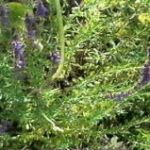
Some five species of aromatic, herbaceous perennials and evergreen or semi-evergreen shrubs are included in this genus, which occurs in dry, sandy or rocket areas from Mediterranean regions to C Asia. Hyssopus officinalis is an excellent plant for borders or informal hedging, with colorful flowers that attract bees and butterflies. It may also be grown as a low, clipped hedge in knot gardens. The smaller rock hyssop is a useful late-flowering subject for edging, rock gardens, and containers. Hyssopus is the name used by Hippocrates, derived from the Hebrew ezob, “holy herb”. Hyssop is an ancient herb, mentioned several times in the Old Testament for purification, though these references may possibly be to Origanum syriacum (See, Syrian Oregano), rather than to H. officinalis. It contains a camphoraceous volatile oil, and compounds similar to those found in Marrubium vulgare (See, horehound); hence its effectiveness for bronchial complaints, for which it has been used from ancient times.
Hyssop was recommended by the ancient Greek physician Hippocrates as a treatment for chest complaints, and it is still used today to treat colds, flu, bronchitis, and other respiratory disorders. This makes sense, as the herb contains marrubiin, a substance that has antiviral and antibiotic activities and also functions as a strong expectorant.
Semi-evergreen shrub with linear to narrowly lanceolate leaves, 2.5-5cm (1-2in) long. Dark blue (rarely pink or white), 2-lipped flowers, 1.5cm (½in) long, are produced in dense spikes in late summer.
Has pure white flowers. Subsp. aristatus f. roseus |
||||||||||
A bitter, aromativ, astringent herb that is expectorant, reduces inflammation, and lowers fever. It has a tonic effect on the digestive, urinary, nervous and bronchial systems. |
||||||||||
This herb, in the form of essential oil, is subject to legal restrictions in some countries. |
||||||||||
|
||||||||||
To treat colds, diseases of the respiratory tract, liver problems, asthma, colic, and urinary tract inflammation. Hyssop has antiflatulence, antiseptic, antispasmodic, astringent, digestive, expectorant, sedating, stomach-soothing, and tonic properties. It is also used as an emmenagogue, that is, an herb that brings on delayed menstrual periods. Hyssop is taken internally for anxiety, bronchitis, colds, congestion, coughs, cramps, flatulence, indigestion, and rheumatism. It is applied externally, in compresses, to treat burns, cold sores, genital herpes, minor wounds, and skin irritations. Hyssop is also used as a gargle for sore throats. |
||||||||||
|
||||||||||
| CIRCULATORY | RESPIRATORY | NERVOUS |
| Hyssop 4 | Hyssop 4 | Hyssop 4 |
| Ylang-Ylang 3 | Sandalwood 3 | Jasmine 4 |
| Rose 3 | Cajeput 3 | Lavender 2 |
| SKIN | EMOTION | |
| Hyssop 4 | Hyssop 4 | |
| Myrrh 4 | Lemon 4 | |
| Cypress 2 | Ylang-Ylang |
Magical Aromatherapy by Scott Cunningham Copyright © 1989 Llewellyn Publications, Inc. pp.96-97
The Encyclopedia of Herbs by Deni Bown Copyright © 1995, 2001 Dorling Kindersley Limited pp. 240-241
The Essential Herb-Drug-Vitamin Interaction Guide by Geo. T. Grossberg,MD and Barry Fox,PhD Copyright©2007 Barry Fox,PhD. Pg.279
The Modern Herbal Primer by Nancy Burke Copyright©2000 Yankee Publishing, Inc. pp. 116-117


